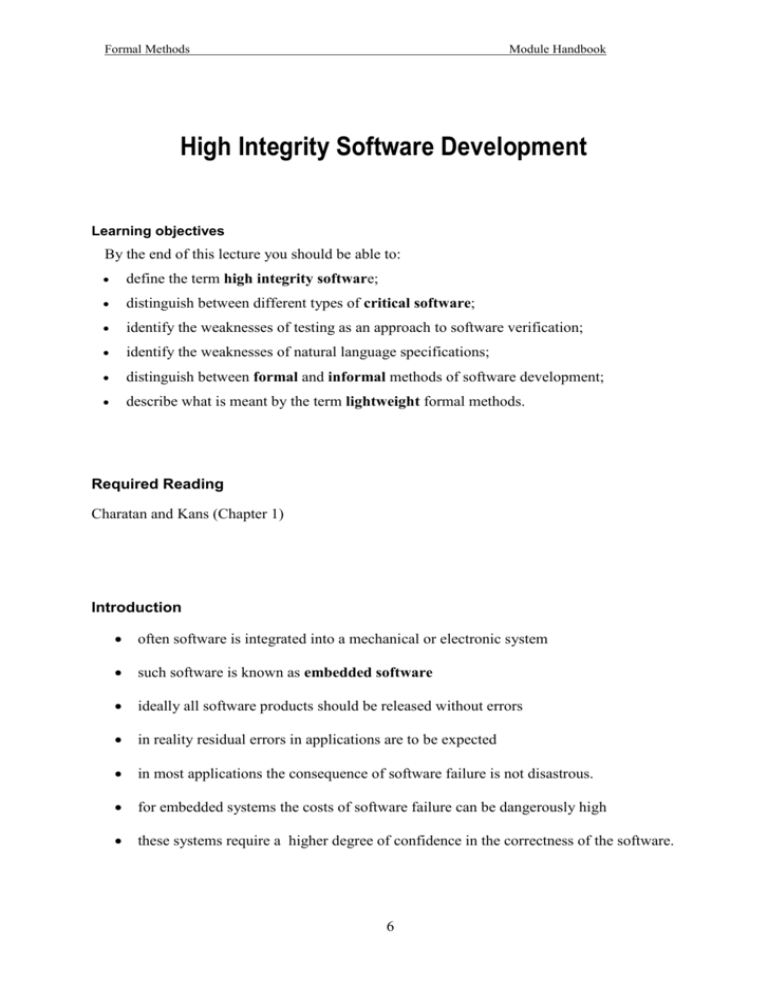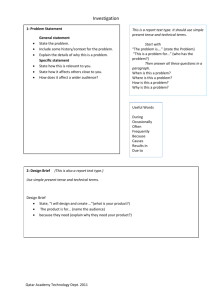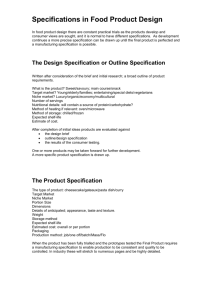microwave style - Personal Home Pages (at UEL)
advertisement

Formal Methods Module Handbook High Integrity Software Development Learning objectives By the end of this lecture you should be able to: define the term high integrity software; distinguish between different types of critical software; identify the weaknesses of testing as an approach to software verification; identify the weaknesses of natural language specifications; distinguish between formal and informal methods of software development; describe what is meant by the term lightweight formal methods. Required Reading Charatan and Kans (Chapter 1) Introduction often software is integrated into a mechanical or electronic system such software is known as embedded software ideally all software products should be released without errors in reality residual errors in applications are to be expected in most applications the consequence of software failure is not disastrous. for embedded systems the costs of software failure can be dangerously high these systems require a higher degree of confidence in the correctness of the software. 6 Formal Methods Module Handbook High Integrity Software Software that has a higher than normal expectation of correctness: high integrity software. Expectation of correctness closely linked to the risks of software failure. The greater the risks the higher the expectation of correctness Therefore, the development of high integrity software demands greater resources than the development of a “regular” software product. Critical Software The term critical software applies to software that poses dangers should it fail. Can further be categorised depending upon the types of danger imposed by failure. business critical software Failure could adversely affect the economic success of an enterprise; examples include the software used to control a bank's ATM transactions and software aimed at providing security for sensitive information. mission critical software Failure could impair the goal of the given mission. Examples here include such applications as satellite and rocket launch systems. safety critical software Failure could result in harm to people, property or the environment. Examples include medical control software and air traffic control software. 7 Formal Methods Module Handbook Integrity Levels Some software is of higher integrity than other software For example, the software used to monitor air traffic flow around an airport is of higher integrity than software used to monitor the temperature in a fridge freezer. We refer to these degrees of integrity as integrity levels. The higher the integrity level of the software, the greater the resources that can be justified in reducing software errors. Table 1.1 Some high profile examples of high integrity software failures The loss of NASA’s Mars The Mars Climate Orbitor was lost because of a type mismatch Climate Orbitor in November error in the software. The assumption was that metric 1999 measurements would be used but the software was developed to use imperial measurements. This resulted in the orbitor attempting to orbit Mars at an altitude of just 37 miles instead of the planned 93 miles. It was believed the minimum altitude at which the orbitor could survive would have been 53 miles. The crash of the European An error in the specification, design and testing procedures of the space agencies Ariane5 rocket fault protection software incorrectly shut down two processors in July 1996 within the first minute of launch. This resulted in the crash of the rocket which took 10 years and 7 billion dollars to develop. Radiation overdoses Software errors that could have resulted in radiation overdose were administered by the Therac-25 undetected for a long period due to the presence of hardware machine in the USA during the locks. Eventually it was decided, for safety reasons, to replace 1980’s. these hardware locks with software locks. These software locks failed to detect the error in the original software resulting in the radiation overdose and death of several patients. 8 Formal Methods Module Handbook The importance of the specification To say a piece of software contains an “error” it means it does not behave as expected. There could be two reasons for this: o either the software does not conform to its specification or o there are errors or omissions in the original specification. For traditional development methods testing aims to locate these software errors. Limitations of Testing 1. Testing cannot take place until some implementation is available. 2. Testing can only help to uncover errors - it cannot guarantee the absence of them. 3. Testing is always carried out with respect to requirements as laid down in the specification. If the specification document is in any way ambiguous it is open to interpretation, and hence misinterpretation. Client The specification Developer Testing Final application Fig 1.1 Ambiguities in the specification and the limitations of testing can result in errors in the final application. 9 Formal Methods Module Handbook UML: a review For the vast majority of software applications in use today, the specification is captured in a mix of natural language and diagrams. For example, the Unified Modelling Language (UML) notation is used to specify and design systems according to the principles of object-oriented development Figure 1.2 depicts a typical UML class diagram specifying a BankAccount class. BankAccount accountNumber:String accountName: String balance: Real deposit (Real) withdraw (Real) : Boolean currentBalance(): Real Fig 1.2 A typical UML diagram for the BankAccount class Often, a diagram such as this is supplemented by a natural language description for each method. For example, the withdraw method of the BankAccount class might have its UML specification supplemented with the following natural language description: withdraw: receives a requested amount to withdraw from the bank account and, if there are sufficient funds in the account, meets the request. Returns a boolean value indicating success or failure of the attempt to withdraw money from the account. 10 Formal Methods Module Handbook Weakness of natural language specifications natural language descriptions are easy to follow by non-computing experts and so provide a good medium for discussions with clients. But natural language descriptions do not have a fixed meaning, they are ambiguous We say these notations do not have a fixed semantics. Revisiting the withdraw method Consider the restrictions placed on the method that the requested amount should be withdrawn only "... if there are sufficient funds ..." What is meant by the term "sufficient"? A boolean value is returned from this method to indicate success or failure: o does a value of false indicate that an error has occurred or that there was no error? The amount to be withdrawn is specified to be a real number; o is this to be a positive or a negative real number? 11 Formal Methods Module Handbook Incomplete specifications A specification can be considered incomplete when the behaviour is not completely defined. In this case the specification of the withdraw method describes what should happen when there are "sufficient" funds in the account, but does not make clear what should happen when there are insufficient funds. Inconsistent specifications A specification is inconsistent when it contains contradictions. For example, an overdraft facility might be specified elsewhere. One interpretation of the withdraw method is that without funds in the bank account a given amount cannot be withdrawn. Both behaviours cannot be satisfied in an implementation. Formal languages To overcome these difficulties it is desirable to use a specification notation with a fixed, unambiguous, semantics. Notations that have a fixed semantics are known as formal notations, or formal languages. A fixed semantics is achieved by defining a language in a completely unambiguous way using a mathematical framework. 12 Formal Methods Module Handbook Formal Methods Formal methods constitute a branch of software engineering that incorporates the use of mathematics for software development. A formal method provides a formal language in which to express the initial specification and all future design steps towards the final program. These design steps are often referred to as transformations. initial formal specification 1st transformation 2nd transformation nth transformation final program Fig 1.3 A formal approach to software development A formal method includes a proof system for demonstrating that each transformation preserves the formal meaning captured in the previous step. A proof system is a means of guaranteeing the correctness of a statement and relies upon mathematical logic. This is a much more robust approach to checking for program correctness than testing alone. 13 Formal Methods Module Handbook Advantages of formal methods: formal specifications can help considerably in generating suitable test cases; the discipline required in producing a formal specification allows for feedback on system specifications at early development stages, increasing confidence that the specification accurately captures the real system requirements; important properties of the initial specification can be checked mathematically and incorporated as run-time checks in the final program; proofs can help uncover design errors as soon as they are made, rather than having to wait for testing of the final implementation; a proof of program correctness can be constructed that is a much more robust method of achieving program correctness than is testing alone. Classifying formal methods Table 1.2 Classifying some leading formal methods Algebraic Sequential systems Model-based Larch Vienna Development Method (VDM) Z B Concurrent Systems Calculus of Communicating Systems (CCS) Prototype Verification System (PVS) OBJ Concurrent Sequential Processes (CSP) The most common and well-established formal methods are those that are modelbased and developed to specify sequential systems. VDM (the Vienna Development Method) is the most mature formal method, having been developed in the late 1970s. 14 Formal Methods Module Handbook Tutorial exercise An application is required to keep track of planes using a particular airport. Before planes can land at the airport, they must first have been granted permission to do so. The following operations are required: Register flight Registers an incoming flight with the airport by submitting its flight with airport number, and its city of origin. Record flight’s Records an incoming flight entering airport airspace, and requesting request to land to land, by submitting its flight number. As long as the plane has previously registered with the airport, the air traffic controller is given an unoccupied runway number on which the plane will have permission to land. If all runways are occupied however, this permission is denied and the air traffic controller is informed to instruct the plane to circle the airport. Record flight Records a flight landing on a runway at the airport by submitting its landing flight number and the runway number. Allow passengers Records passengers boarding a plane by submitting its flight number, to board and its destination city. Record flight take Records a flight taking off from the airport by submitting its flight off number. If there are planes circling the airport, the first plane to have joined the circling queue is then given permission to land on that runway. List arrivals Returns a list of planes whose status is either due-to-land, waiting-toland, or landed. List departures Returns a list of planes whose status is currently waiting-to-depart (taking on passengers). 1. Identify any inadequacies in this specification 2. Identify the permanent data required in this system. 3. Identify any global constraints on this system. 4. Identify constraints (if any) on each operation. 15








